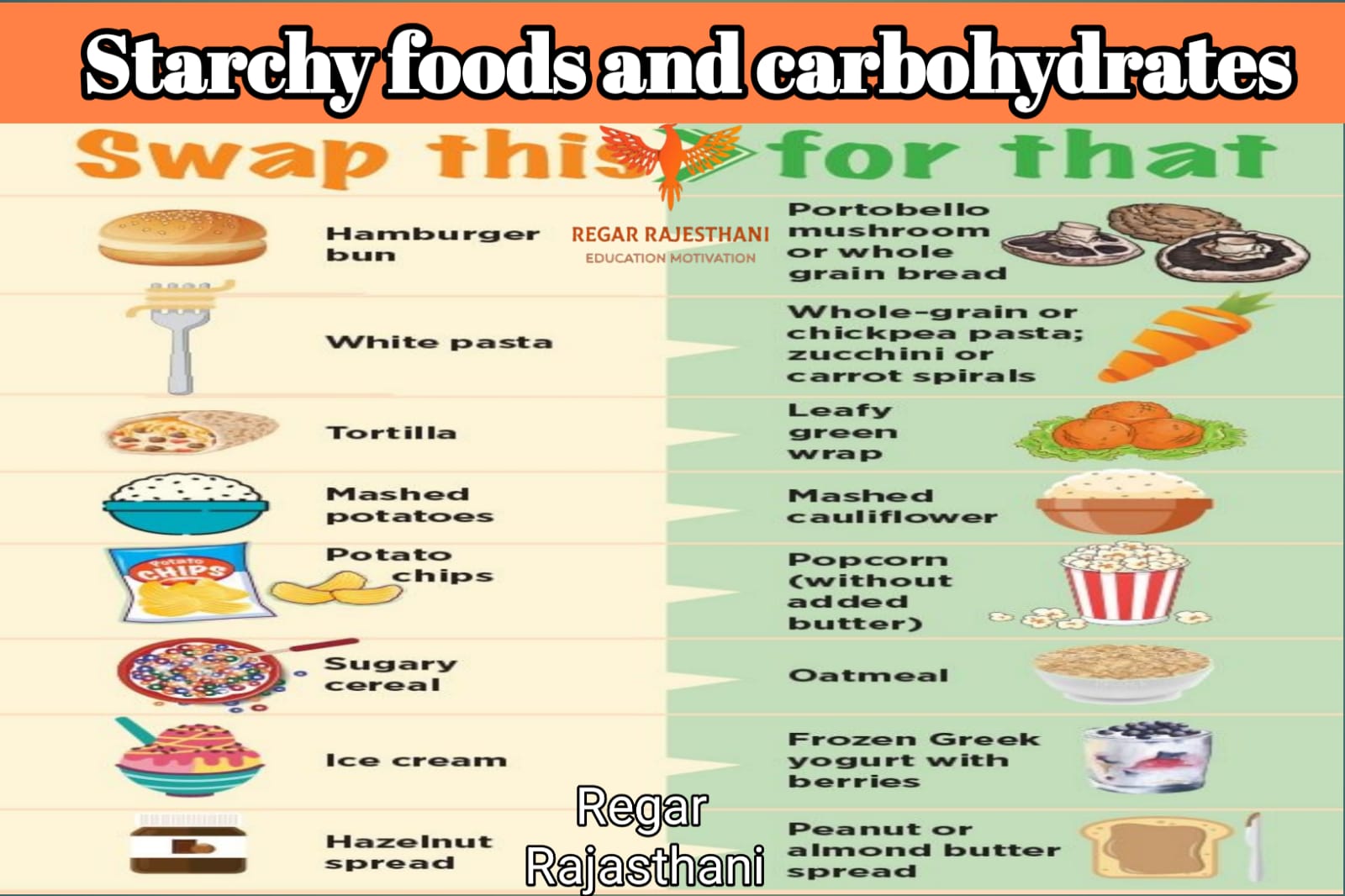"Starchy foods and carbohydrates are essential sources of energy and nutrients for our bodies"
Starchy foods and carbohydrates are esse Starchy foods play a pivotal role as our primary source of carbohydrates and significantly contribute to maintaining a well-rounded and nutritious diet.
The Eatwell Guide emphasizes that these foods, including but not limited to potatoes, bread, rice, pasta, and cereals, should constitute slightly over one-third of our total food consumption. For optimal health benefits,
it is advisable to opt for wholegrain alternatives whenever available, as they offer additional dietary fiber.
Additionally, leaving the skin on potatoes not only enhances their flavor and texture but also boosts their fiber content. By incorporating a variety of starchy foods into our daily meals, we ensure a consistent intake of essential nutrients,
promoting overall well-being and supporting a balanced approach to eating.ntial sources of energy and nutrients for our bodies
Starchy foods are essential for our bodies as they provide vital fuel in the form of carbohydrates, enabling optimal bodily functions and sustained energy levels.
Starchy foods serve as an excellent energy source and are a primary provider of a diverse range of essential nutrients within our diet.
Apart from starch, they encompass valuable components such as fiber, calcium, iron, and B vitamins.
Despite misconceptions about their impact on weight, it's worth noting that gram for gram, starchy foods contain fewer than half the calories found in fats.
However, it's important to be mindful of the added fats used during cooking and serving, as these can increase the overall calorie content.
Maintaining awareness of preparation methods ensures that the nutritional benefits of starchy foods are maximized without compromising a well-balanced approach to calorie intake.
Best Starchy foods and fibre.
Wholegrain varieties of starchy foods and potatoes, especially when consumed with their skin intact, offer a commendable fiber content that contributes to a wholesome diet.
"Best Fiber diet comprises a diverse array of substances present in the cell walls of vegetables and fruits & pulses and cereal grains"
The indigestible nature of certain fibers aids in facilitating the movement of food and waste products along the digestive tract.
Excellent sources of this beneficial fiber include potato skins, wholegrain bread, breakfast cereals, brown rice, and wholewheat pasta. Incorporating fiber into your eating habits not only promotes healthy bowel function but also induces a sense of satiety, which can help prevent excessive food consumption.
This quality makes wholegrain starchy foods and potatoes consumed with their skin on an especially favorable choice for individuals aiming to achieve weight loss goals.
Additionally, specific types of fiber found in fruits and vegetables like apples, carrots, and potatoes, as well as oats and pulses, possess the ability to be partially digested and may contribute to reducing cholesterol levels in the bloodstream.
By incorporating these fiber-rich foods into your diet, you can foster both digestive health and heart well-being.
Best Tips for eating more starchy foods plan.
Best Breakfast Plan
Opt for wholegrain cereals or mix them with your preferred healthy breakfast cereals.
Enjoy a comforting winter breakfast by having plain porridge with fruit.
Indulge in a delicious summer breakfast by combining whole oats with fruit and low-fat, lower-sugar yogurt.
In summary, you can choose between wholegrain cereals, warm and fruity porridge for winter mornings, or refreshing combinations of whole oats, fruit, and low-fat yogurt for summer breakfasts.
Best Starchy Plan Lunch and dinner.
Lunch:
Opt for a baked potato, and be sure to consume the skin to maximize your fiber intake.
Instead of chips or fried potatoes, try making oven-baked potato wedges for a healthier alternative.
Dinner:
Include more rice or pasta in your meals, while reducing the amount of sauce.
However, remember to incorporate plenty of vegetables.
Explore different bread options like seeded, wholemeal, or granary varieties.
Choosing wholegrain options will further increase your fiber consumption.
Experiment with brown rice, which can be used to create delicious rice salads.
To summarize, incorporating a baked potato with the skin, making oven-baked potato wedges, opting for rice or pasta with less sauce and more vegetables, trying wholegrain bread options, and exploring brown rice in rice salads can provide you with nutritious and fiber-rich lunch and dinner options.
Best Types of starchy foods.
Potatoes
Potatoes are an excellent choice as a starchy food, providing energy, fiber, B vitamins, and potassium.
In the UK, potatoes also contribute to our vitamin C intake, even though they contain only a small amount of it.
Potatoes are considered a starchy food rather than a vegetable in the UK, and they play a significant role in our carbohydrate intake.
While potatoes don't count towards the recommended five portions of fruits and vegetables, they still have an important place in a balanced diet.
Healthy cooking methods for potatoes include boiling, baking, mashing, or roasting with minimal fat or oil and no added salt.
French fries and chips cooked in oil or with added salt are not a healthy choice.
Opt for lower-fat spreads or small amounts of unsaturated oils like olive or sunflower oil when cooking or serving potatoes.
Use lower-fat milk, such as semi-skimmed or skimmed, instead of whole milk or cream for mashed potatoes.
Retain potato skins whenever possible to preserve more fiber and vitamins, especially when boiling or baking them.
When boiling potatoes, minimize nutrient loss by using only enough water to cover them and cooking them for the required time.
Store potatoes in a cool, dark, and dry place or in the refrigerator to prevent sprouting. Avoid consuming green, damaged, or sprouting parts, as they may contain harmful toxins.
Bread
Bread, particularly wholemeal, granary, brown, and seeded varieties, is a healthy choice as part of a balanced diet.
"Wholegrain & wholemeal and brown breads provide energy and B vitamins or vitamin E ,fiber, and various minerals."
While white bread also contains vitamins and minerals, it has less fiber compared to wholegrain, wholemeal, or brown bread. If you prefer white bread, opt for higher-fiber options.
Some individuals avoid bread due to concerns about food intolerance or wheat allergies, or the perception that bread contributes to weight gain.
However, eliminating any food completely from your diet may lead to missing out on essential nutrients necessary for maintaining good health.
If you're worried about a potential wheat allergy or intolerance, it's advisable to consult with a GP.
Bread can be stored at room temperature, and it's important to check the "best before" date to ensure its freshness.
Cereal products
"Cereal products are derived from grains and can contribute to our daily intake of iron and fiber & B vitamins and protein or especially when they are wholegrain"
Wholegrain cereals offer the added benefits of slow energy release and higher fiber content.
Commonly available cereals like wheat, oats, barley, rye, and rice can be consumed in their wholegrain form.
Healthy breakfast options include cereal products such as oats or oatmeal (e.g., porridge) and wholewheat products.
Other cereal products, such as barley, couscous, corn, and tapioca, are also considered healthy choices.
It's important to note that many cereal products in the UK are refined and have low wholegrain content. They may also contain high amounts of added salt and sugar.
When shopping for cereals, it is recommended to check the food labels to compare different products and make informed choices.
Rice and grains
"Rice and grains are an excellent choice as starchy foods & providing energy and being low in fat and offering good value for money"
There are various types of rice to choose from, including quick-cook, arborio, basmati, long grain, brown, short grain, and wild. Other options include couscous and bulgur wheat.
Rice and grains, especially brown and wholegrain varieties, also contain fiber, which aids in waste elimination, and B vitamins, important for energy release and proper bodily function.
Rice and grains can be enjoyed hot or cold, and are commonly used in salads.
It's important to handle cooked rice and grains carefully due to the potential presence of food poisoning bacteria.
Spores can germinate if cooked rice or grains are left at room temperature, leading to the production of toxins that can cause illness.
Serve rice and grains as soon as they are cooked or, if not possible, cool them within an hour and refrigerate them until reheating or using them in recipes.
Rice and grains that have been left at room temperature overnight should be discarded.
If you are not consuming cooked rice immediately, refrigerate it within an hour and consume it within 24 hours.
Thoroughly reheat rice, ensuring it reaches a core temperature of 70°C for 2 minutes (or equivalent) to ensure it is steaming hot throughout.
Rice should not be reheated more than once, and it should be discarded if not chilled safely and stored in a refrigerator.
For store-bought cold rice or grain salads, follow the "use by" date and storage instructions on the label.
Pasta in your diet
Pasta is a healthy option for building meals, made from durum wheat and water, and contains iron and B vitamins.
Wholewheat or wholegrain pasta is a healthier choice compared to regular pasta because it contains more fiber.
The slower digestion of wholegrain foods can help keep us feeling full for longer.
Dried pasta can be conveniently stored in a cupboard and generally has a long shelf life. On the other hand, fresh pasta needs refrigeration and has a shorter lifespan.
When purchasing pasta, check the food packaging for "best before" or "use by" dates, as well as any specific storage instructions.
Acrylamide in starchy food.
Acrylamide is a chemical that forms when starchy foods like potatoes and bread are cooked at high temperatures for extended periods, such as baking, frying, grilling, toasting, and roasting.
There is evidence indicating that acrylamide can contribute to the development of cancer.
The Food Standards Agency provides tips to help reduce the risk of acrylamide exposure at home:
Aim for a golden yellow color, or lighter, when baking, toasting, roasting, or frying starchy foods like potatoes, root vegetables, and bread.
Follow the cooking instructions carefully when preparing packaged food products like chips, roast potatoes, and parsnips, ensuring you do not cook them for too long or at excessively high temperatures.
Maintain a varied and balanced diet to reduce the overall risk of cancer.
This includes basing meals on starchy carbohydrates and ensuring you consume your recommended 5 A Day of fruits and vegetables.
Instead of frying or roasting potatoes and root vegetables, consider boiling or steaming them.
This cooking method reduces the risk of acrylamide exposure and helps lower fat consumption.






.png)




0 Comments